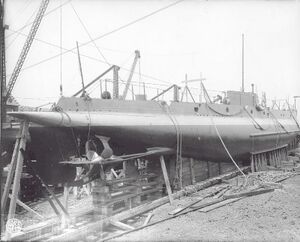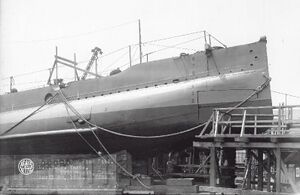L-5: Difference between revisions
Pbcjohnston (talk | contribs) mNo edit summary Tag: Reverted |
Pbcjohnston (talk | contribs) mNo edit summary Tag: Manual revert |
||
| Line 3: | Line 3: | ||
[[File:L5bow.jpg|left|thumb|Photo courtesy of The US Navy Submarine Force Library & Museum.]] | [[File:L5bow.jpg|left|thumb|Photo courtesy of The US Navy Submarine Force Library & Museum.]] | ||
<br><br><br><br><br><br><br><p align="justify"><font color="#000066">The bow of L-5 on the building ways at the Lake yard in Bridgeport, CT., April 30, 1916. The outer shutter doors for two of her four 18-inch torpedo tubes can be seen, just below the typical Lake-style raised bow. One set of three amidships diving planes are visible folded against the hull just above the beginning of the bilge keel. Lake used three sets of amidships diving planes in place of the more common single set of bow diving planes. The amidships planes supposedly enabled level diving without having to take an angle. In practice, it didn't provide a significant safety advantage as claimed, and the Navy didn't like the feature. Above and aft of the diving plane is a circular flood port for the semi-watertight superstructure.</font> | <br><br><br><br><br><br><br><br><p align="justify"><font color="#000066">The bow of L-5 on the building ways at the Lake yard in Bridgeport, CT., April 30, 1916. The outer shutter doors for two of her four 18-inch torpedo tubes can be seen, just below the typical Lake-style raised bow. One set of three amidships diving planes are visible folded against the hull just above the beginning of the bilge keel. Lake used three sets of amidships diving planes in place of the more common single set of bow diving planes. The amidships planes supposedly enabled level diving without having to take an angle. In practice, it didn't provide a significant safety advantage as claimed, and the Navy didn't like the feature. Above and aft of the diving plane is a circular flood port for the semi-watertight superstructure.</font> | ||
Revision as of 11:59, 15 April 2023

L-5 under construction at the Lake yard, Bridgeport, CT., April 30, 1916. She would be launched the next day. The Lake design had the stern end in a flat, horizontal "shovel", with the rudder, stern diving planes, and propeller shafts mounted ventrally under the stern. In an effort to preserve buoyancy while surfaced, portions of the superstructure atop the hull were intended to be watertight. The small round holes on the side were actually for flood port valves for these superstructure buoyancy tanks. The fairwater around the conning tower can be seen in the center.

The bow of L-5 on the building ways at the Lake yard in Bridgeport, CT., April 30, 1916. The outer shutter doors for two of her four 18-inch torpedo tubes can be seen, just below the typical Lake-style raised bow. One set of three amidships diving planes are visible folded against the hull just above the beginning of the bilge keel. Lake used three sets of amidships diving planes in place of the more common single set of bow diving planes. The amidships planes supposedly enabled level diving without having to take an angle. In practice, it didn't provide a significant safety advantage as claimed, and the Navy didn't like the feature. Above and aft of the diving plane is a circular flood port for the semi-watertight superstructure.